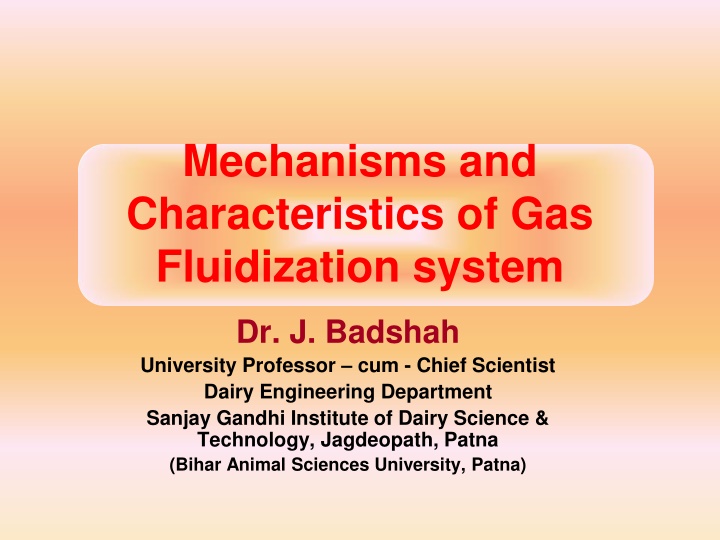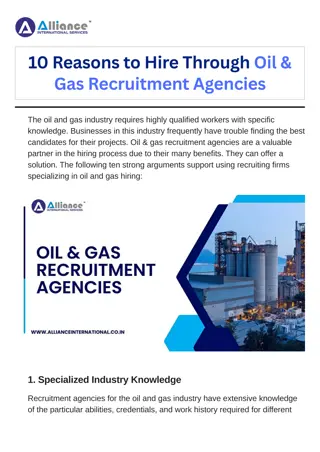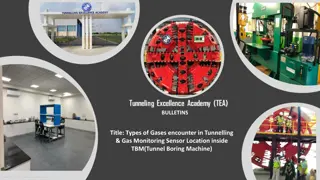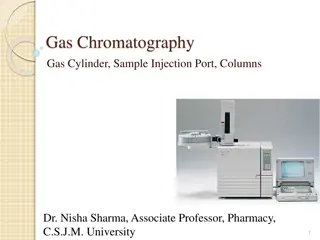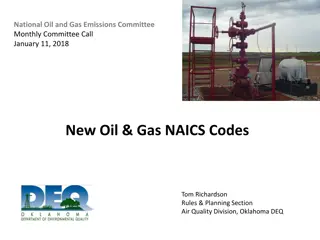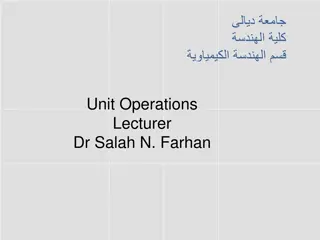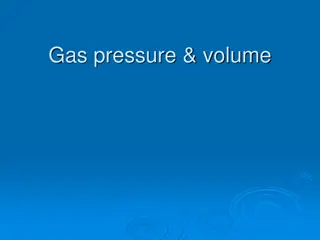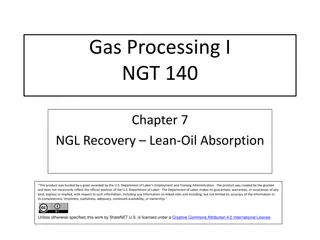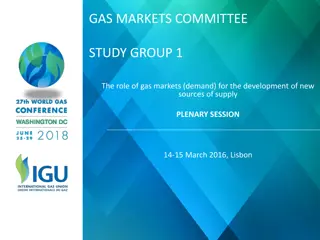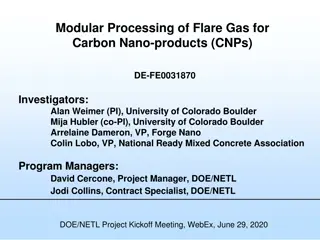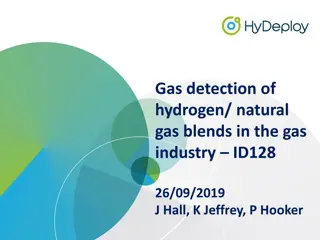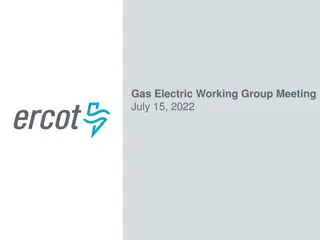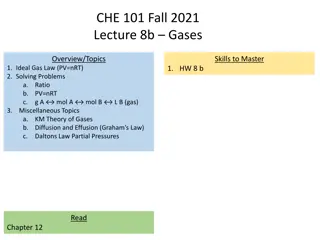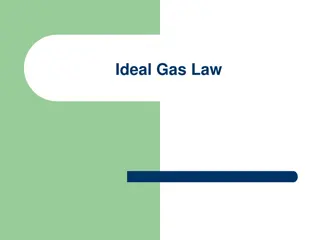Gas Fluidization Mechanisms & Characteristics
Gas fluidization plays a vital role in the production of powder-like products and instantization processes. Understanding the mechanisms of fluidization and the conditions for bed expansion is essential for optimizing operations in various industries. This article delves into the intricacies of fluidization systems, highlighting the stages of fluidization, the benefits of agglomeration, and the application of fluidization in instantization. It also explores mechanically agitated/vibrated fluidized bed dryers and the importance of particle behavior in achieving optimal fluidization.
Download Presentation

Please find below an Image/Link to download the presentation.
The content on the website is provided AS IS for your information and personal use only. It may not be sold, licensed, or shared on other websites without obtaining consent from the author.If you encounter any issues during the download, it is possible that the publisher has removed the file from their server.
You are allowed to download the files provided on this website for personal or commercial use, subject to the condition that they are used lawfully. All files are the property of their respective owners.
The content on the website is provided AS IS for your information and personal use only. It may not be sold, licensed, or shared on other websites without obtaining consent from the author.
E N D
Presentation Transcript
Mechanisms and Characteristics of Gas Fluidization system Dr. J. Badshah University Professor cum - Chief Scientist Dairy Engineering Department Sanjay Gandhi Institute of Dairy Science & Technology, Jagdeopath, Patna (Bihar Animal Sciences University, Patna)
Application of Fluidization in Instantization Most powder-like products produced by spray drying or grinding are dusty, exhibit poor flow characteristics and are difficult to rehydrate. It is well known, however, that agglomeration in most instances will improve the redispersion characteristic i.e wettability, dispersability, sinkability and solubilty charateristics of powder. Fluidized bed drying is an integral part of instantization. Added benefits of agglomerated or instantized powders are that they exhibit improved flow ability and are non-dusting along with improved thermal efficiency of the system.
Mechanism of Fluidization Fluidization of fixed bed takes place in distinct stages of air velocity and trans bed pressure drop. The powdered products are made to flow through a permeable support, when gas is passed. Initially, the air cannot escape the bed, and the bed remains stagnant. As the pressure drop across the bed keeps increasing, the bed slowly expands in its height. At still greater velocities the particles in the bed will begin to be in turbulent motion. All particles of the product are thoroughly mixed in the turbulent layer and they dry therefore at a uniform rate. A further increase in the stream of gas finally leads to a velocity at which the particles float, which occurs when the upward force equals the force of gravity acting on the particles. Fluidization occurs between expansion of bed and floatation of particles. Beyond this velocity it is impossible to maintain a fluidized bed and the particles are carried away in the gas stream (pneumatic conveying).
Conditions to start the expansion of bed Force of gravity acting on the bed: P = H0 . g( k- A) (1- 0) Where, H0= depth of the bed of material at rest k= density of the individual particles A= density of the air 0= porocity of the bed at rest (usually 0= 0.4) The pressure drop of the gas on passing through the bed is: P = 64 ( 1/ 2) { (1/Re) + ( /64)} (H0/d*) ( A/2 ) v2 , where 1= factor due to increase in length of the path, 1= 0.75 for Beds Re = Reynold s number, composed of d* and V = v/ 0 = resistance coefficient for turbulent flow v= velocity of gas based on the cross section of empty tower d* = the hydraulic diameter of the pores The above equation is valid for laminar, transition and turbulent flow. When the force of gravity equals the pressure drop, the bed starts to expand at that velocit of gas.
Mechanically Agitated/vibrated Fluidized Bed Dryer Particles of a moist product can be put into turbulent motion using only air provided their surfaces are not stuck together by moisture or thermoplasticity using simple installation of FBD. If particles stick together initially, stable fluidized beds can be produced by using mechanical stirrer/agitator to break up particle agglomerates. An agitated fluid bed dryer (AFBD)* of pilot-scale capacity was designed to study the effect of the type of agitator and its speed, gas velocity, and inlet temperature and feed loading on the hydrodynamic performance of the AFBD. Key hydrodynamic parameters such as pressure drop have a profound influence on determining the fluidization characteristics. The pressure drop across the AFBD system was expressed in terms of flow coefficient, , which can be conveniently used as a design parameter. The choice of agitator has an even greater influence on the drying kinetics and the results have been summarized, paving the way for a more efficient spiral agitator of the helical ribbon type.(*J. of Drying Technology, vol. 29, 2011-Issue 7, pages:808-818.)
Vibrated Fluid bed Dryers The vibration fluidized bed has the advantage of forced conveyance in a given direction, fluidization even at low air velocities and a residence time of the product which can be at least partially controlled. For sticky products, forced mixing and transport is provided by much employed vibration fluidized bed drier. The dryer is based on a vibrating conveyor trough which can be up to 10 m long and up to 1 m wide. Eccentric motors produce the vibration of the drier which may be supported on helical or leaf springs. The changing in rotation of motors can change direction of vibration and changing in eccentricity of motor can change the amplitude of vibration. To ensure a uniform distribution of air over the whole area of the air permeable base plate the resistance offered by the plate to the air flow should be in the range of 1000 to 2000 Pa, depending on the type of product and the depth of the bed. The perforations occupy usually between 1.5 and 5 % of the area of the plate, and the depth of the bed, which can be adjusted by means of an overflow weir, is usually between 50 and 300 mm.
